|
|
||
* You can search this page for a specific year or person by using the combination of the keys Ctrl F on your keyboard.
![]()
1871
Friedrich Gleich and A. Frew established a brewery in Albury NSW, trading under the name Gleich and Co. The "Albury Border Post" called the brewery at the time the German Brewery. The brewery claimed to be the only Australian brewery producing a "pure German ale". In 1874 it was taken over and its equipment moved to another Albury brewery.
1877
The Hermannsburg Lutheran Mission was established on the Finke River in the
centre of the continent by W.F. Schwarz, from Württemberg, L.G. Schulze from
Saxony and A.H. Kempe, from Dauben near Dresden.
More...
1879
![]() The German Empire's first General Consulate in Australia was opened at Sydney.
It was headed by the first full-time professional diplomat from Germany, Dr
Richard Krauel, and was responsible for "Australia, Tasmania, New Zealand
and the Fiji Islands". German was spoken at Dr Krauel's first meeting with
Lord Augustus Loftus, the Governor of New South Wales.
The German Empire's first General Consulate in Australia was opened at Sydney.
It was headed by the first full-time professional diplomat from Germany, Dr
Richard Krauel, and was responsible for "Australia, Tasmania, New Zealand
and the Fiji Islands". German was spoken at Dr Krauel's first meeting with
Lord Augustus Loftus, the Governor of New South Wales.
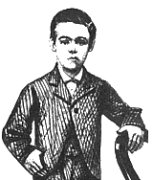
![]() (<<) August
("Gus") Wernicke was recruited by the bushranger (outlaw) Andrew George
Scott (alias Captain Moonlite); at the age of 15 Wernicke was Australia's
youngest bushranger ever. He was born in Fitzroy, Melbourne, in 1864, the eldest
child of the German immigrant Ernst Ludwig Wernicke and his (presumably) Anglo
wife Annie Grieve. Gus first met Scott/Moonlite in a brothel. Captain Moonlite's
gang was intercepted by police troopers between Wagga Wagga and Gundagai in
southern New South Wales on Monday 17th November. The gang forced Edmund and
Ann McGlede to give them breakfast in their two-room farmhouse, and were trapped
there by the troopers. During the shootout Wernicke went outside to try to outflank
the troopers but was shot in the side by Trooper Barry. He is reputed to have
cried out: "Oh God! I am shot, and I'm only 15." He died a few days
later. Captain Moonlite and another gang member who survived the shootout were
hanged at Darlinghurst, Sydney on 20th January 1880.
(<<) August
("Gus") Wernicke was recruited by the bushranger (outlaw) Andrew George
Scott (alias Captain Moonlite); at the age of 15 Wernicke was Australia's
youngest bushranger ever. He was born in Fitzroy, Melbourne, in 1864, the eldest
child of the German immigrant Ernst Ludwig Wernicke and his (presumably) Anglo
wife Annie Grieve. Gus first met Scott/Moonlite in a brothel. Captain Moonlite's
gang was intercepted by police troopers between Wagga Wagga and Gundagai in
southern New South Wales on Monday 17th November. The gang forced Edmund and
Ann McGlede to give them breakfast in their two-room farmhouse, and were trapped
there by the troopers. During the shootout Wernicke went outside to try to outflank
the troopers but was shot in the side by Trooper Barry. He is reputed to have
cried out: "Oh God! I am shot, and I'm only 15." He died a few days
later. Captain Moonlite and another gang member who survived the shootout were
hanged at Darlinghurst, Sydney on 20th January 1880.
![]() Count Reinhold of Anrep-Elmpt passed through Kelly country in December and encountered
the bushranger Ned Kelly in the bush near Beechworth, north-eastern Victoria.
He had arrived in Sydney in 1878 after having already travelled around the world
for nearly ten years. He travelled through New South Wales, Queensland, Victoria
and South Australia on foot, by horse, stagecoach, river steamship, coastal
steamship and train. In 1886 he published a massive three-volume book about
his Australian travels.
Count Reinhold of Anrep-Elmpt passed through Kelly country in December and encountered
the bushranger Ned Kelly in the bush near Beechworth, north-eastern Victoria.
He had arrived in Sydney in 1878 after having already travelled around the world
for nearly ten years. He travelled through New South Wales, Queensland, Victoria
and South Australia on foot, by horse, stagecoach, river steamship, coastal
steamship and train. In 1886 he published a massive three-volume book about
his Australian travels.
Read the Count's description of the Kelly meeting...
1879-1880
![]() At the International Exhibitions at Sydney (1879) and at Melbourne (1880) German
companies made a concerted effort to promote their products and won first prizes
for a variety of consumer goods.
At the International Exhibitions at Sydney (1879) and at Melbourne (1880) German
companies made a concerted effort to promote their products and won first prizes
for a variety of consumer goods.
More on the Exhibitions...
![]() In 1879 the Austrian Carl Ludwig Pinschof came to Australia for the first time,
as an Austrian trade agent for the International Exhibition held in Sydney.
Noticing the possibilities in Australian trade, in 1880 he published Sydney
und Melbourne, Bemerkungen und Ratschläge für Aussteller (Sydney and Melbourne,
Comments and Advice for Exhibitors). He settled in Melbourne in that year and
began a distinguished career in business. He was the first Chairman of Directors
of Carlton & United Breweries, and became a Director of the Herald and Weekly
Times in 1900. From 1885 to 1908 he was Honorary Consul in Melbourne for the
Austro-Hungarian Empire. Pinschof was a respected authority on financial issues.
Despite being naturalised in 1909 he was discriminated against in World War
One and had to resign his directorships. He had met his wife, Elise Wiedermann,
who was a famous opera singer, in Vienna, and they got married on the day of
her arrival in Melbourne in 1893. They supported artists and musicians, and
their homes Studley Hall in Kew and Hohe Warte at Macedon were centres of artistic
life. The Australian singer Nellie Melba decided to study with Madame Mathilde
Marchesi in Paris upon the recommendation of Elise Pinschof, who had studied
with Marchesi. The Pinschofs financed Tom Roberts's large painting Opening
of the First Parliament (Australia's first Federal Parliament in 1901) and
they can be seen clearly in the painting. The painting is now in the High Court
Building in Canberra.
In 1879 the Austrian Carl Ludwig Pinschof came to Australia for the first time,
as an Austrian trade agent for the International Exhibition held in Sydney.
Noticing the possibilities in Australian trade, in 1880 he published Sydney
und Melbourne, Bemerkungen und Ratschläge für Aussteller (Sydney and Melbourne,
Comments and Advice for Exhibitors). He settled in Melbourne in that year and
began a distinguished career in business. He was the first Chairman of Directors
of Carlton & United Breweries, and became a Director of the Herald and Weekly
Times in 1900. From 1885 to 1908 he was Honorary Consul in Melbourne for the
Austro-Hungarian Empire. Pinschof was a respected authority on financial issues.
Despite being naturalised in 1909 he was discriminated against in World War
One and had to resign his directorships. He had met his wife, Elise Wiedermann,
who was a famous opera singer, in Vienna, and they got married on the day of
her arrival in Melbourne in 1893. They supported artists and musicians, and
their homes Studley Hall in Kew and Hohe Warte at Macedon were centres of artistic
life. The Australian singer Nellie Melba decided to study with Madame Mathilde
Marchesi in Paris upon the recommendation of Elise Pinschof, who had studied
with Marchesi. The Pinschofs financed Tom Roberts's large painting Opening
of the First Parliament (Australia's first Federal Parliament in 1901) and
they can be seen clearly in the painting. The painting is now in the High Court
Building in Canberra.
1880s
The big German clubs of the capital cities were established, eg Brisbane Turnverein, Sydney Concordia Club, Melbourne Tivoli, Helvetia (Swiss, in Melbourne), Südaustralischer Allgemeiner Deutscher Verein Inc.
1880s-1890s
These years saw a large number of desertions of sailors from warships of the
Austro-Hungarian Empire and particularly of the German Empire while in Australian
ports. Many were presumably sick of life on navy ships and liked the look of
Australia. Some were caught by colonial police and returned to their ship or
put on another ship of the same navy if their ship had left port. Not all of
them could speak English. Rewards were offered by some of their ships. Between
1852 and 1900, according to nationality, German deserters made up the fourth-highest
number of deserters in the port of Sydney, after Englishmen, Irishmen and Scots.
More on German deserters...
1880
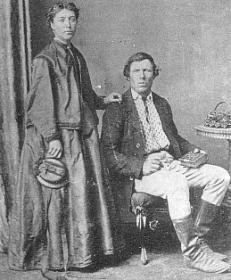 On
Saturday, 26th June, a German market-gardener and miner named Anton Wick living
near Beechworth (north-eastern Victoria) was forced to assist Australia's most
notorious bushrangers (outlaws), the Kelly Gang. A criminal named Aaron Sherritt
was a friend of the Kelly Gang (a close friend of Joe Byrne since childhood)
but had for some time been giving the police information on the gang's movements
(initially, apparently, in an attempt to buy life imprisonment for Joe Byrne
rather than hanging). At about 6 o'clock in the evening Anton Wick left his
house opposite the Woolshed school, in the Woolshed Valley 6.5 km from Beechworth.
He planned to visit his friends, the Weiners, and enjoy a chat in German. As
he passed, he saw that light was on in Aaron Sherritt's cottage, but noone was
home at the Weiner's cottage next door. On the way back home he encountered
Joe Byrne and Dan Kelly, who handcuffed him. Anton's daughter Annie had been
a schoolmate of Joe and Aaron. Joe Byrne told Anton that he remembered that
Anton had once reported him to police (regarding theft of Anton's horse in 1873,
when Joe was 16; Joe had been fined by the judge), but that he forgave
Anton for that. Dan Kelly and Joe Byrne took Anton Wick, whom Sherritt knew
well, and forced him to knock on the back door of Sherritt's hut and call out
that he needed some help in finding his way home. When Sherritt recognised Anton's
German accent and opened the door, Joe Byrne shot him dead. Kelly and Byrne
let Anton go home. Anton Wick, who had arrived in Australia in 1861, died on
14th March 1893 at 66 years of age and was buried in Beechworth cemetery. (Photo
shows Anton and his wife Margaret, born in Hessen, who died in 1869 aged 44.)
On
Saturday, 26th June, a German market-gardener and miner named Anton Wick living
near Beechworth (north-eastern Victoria) was forced to assist Australia's most
notorious bushrangers (outlaws), the Kelly Gang. A criminal named Aaron Sherritt
was a friend of the Kelly Gang (a close friend of Joe Byrne since childhood)
but had for some time been giving the police information on the gang's movements
(initially, apparently, in an attempt to buy life imprisonment for Joe Byrne
rather than hanging). At about 6 o'clock in the evening Anton Wick left his
house opposite the Woolshed school, in the Woolshed Valley 6.5 km from Beechworth.
He planned to visit his friends, the Weiners, and enjoy a chat in German. As
he passed, he saw that light was on in Aaron Sherritt's cottage, but noone was
home at the Weiner's cottage next door. On the way back home he encountered
Joe Byrne and Dan Kelly, who handcuffed him. Anton's daughter Annie had been
a schoolmate of Joe and Aaron. Joe Byrne told Anton that he remembered that
Anton had once reported him to police (regarding theft of Anton's horse in 1873,
when Joe was 16; Joe had been fined by the judge), but that he forgave
Anton for that. Dan Kelly and Joe Byrne took Anton Wick, whom Sherritt knew
well, and forced him to knock on the back door of Sherritt's hut and call out
that he needed some help in finding his way home. When Sherritt recognised Anton's
German accent and opened the door, Joe Byrne shot him dead. Kelly and Byrne
let Anton go home. Anton Wick, who had arrived in Australia in 1861, died on
14th March 1893 at 66 years of age and was buried in Beechworth cemetery. (Photo
shows Anton and his wife Margaret, born in Hessen, who died in 1869 aged 44.)
1881
![]() Sorell Creek, in the mountains 18 kilometres north-west of Hobart in Tasmania,
was proclaimed a town and renamed Bismarck, in recognition of the many German
settlers there (Otto
von Bismarck was Chancellor of Germany). The Tasmanian government wanted
to attract German settlers by offering free land. In August 1870 the Victoria
arrived in Hobart with German immigrants who soon moved up to Sorell Creek.
The first settler up there was English, but many Germans soon followed, and
Danes also. Small-fruits (e.g. strawberries, blackcurrants, raspberries, plums
and gooseberries), sent to Hobart and Melbourne, were an important part of Bismarck's
economy, as was logging and saw milling. Bismarck was known for its axemen.
In November 1914, shortly after the start of World War One, petitions were submitted
to the Tasmanian government by Bismarck's English faction and by its German
faction (about half the town's population was of German origin), the first petition
requesting a name change and the second one opposing it. The name Bismarck was
changed to Collinsvale, which matched nearby locality names of Collins Cap and
Collins Bonnet. Collinsvale remained quite self-sufficient and isolated from
the outside world for many years.
Sorell Creek, in the mountains 18 kilometres north-west of Hobart in Tasmania,
was proclaimed a town and renamed Bismarck, in recognition of the many German
settlers there (Otto
von Bismarck was Chancellor of Germany). The Tasmanian government wanted
to attract German settlers by offering free land. In August 1870 the Victoria
arrived in Hobart with German immigrants who soon moved up to Sorell Creek.
The first settler up there was English, but many Germans soon followed, and
Danes also. Small-fruits (e.g. strawberries, blackcurrants, raspberries, plums
and gooseberries), sent to Hobart and Melbourne, were an important part of Bismarck's
economy, as was logging and saw milling. Bismarck was known for its axemen.
In November 1914, shortly after the start of World War One, petitions were submitted
to the Tasmanian government by Bismarck's English faction and by its German
faction (about half the town's population was of German origin), the first petition
requesting a name change and the second one opposing it. The name Bismarck was
changed to Collinsvale, which matched nearby locality names of Collins Cap and
Collins Bonnet. Collinsvale remained quite self-sufficient and isolated from
the outside world for many years.
![]() Queensland had the highest proportion of German-speaking immigrants (5.5% of
its population), and Tasmania had the lowest (less than 1%).
Queensland had the highest proportion of German-speaking immigrants (5.5% of
its population), and Tasmania had the lowest (less than 1%).
1882
On 31st August the sailing ship Duchess of Edinburgh arrived in Sydney from England, bringing ten German nuns of the Ursuline Order, along with three trainees. Bishop Torreggiani of Armidale, who had met them earlier in England, had invited them to work in his diocese, which covered a very large geographic area at that time. The Ursuline nuns had been expelled from their school and lands at Duderstadt as a result of the clash, known as the Kulturkampf, between Bismarck (Chancellor of the recently united German Empire) and the Catholic Church. In 1873 the Prussian-dominated German Parliament passed laws which took education out of the hands of the church, and which closed down all religious teaching organisations and confiscated their property. In 1877 the nuns were suddenly ordered to leave the convent by 1st October. 21 Duderstadt nuns moved to England and opened a school in a house at Greenwich. By 1881 the Ursulines were experiencing financial problems and were very happy when the invitation from Bishop Torreggiani of Armidale arrived on 26th December. Opportunities for a Catholic education in Armidale were very limited before the Ursuline Sisters arrived. The Sisters had to adjust to a different environment. Most of them were from the German upper class, and highly-educated and cultured women, and came to a small country town in Australia. They were German Catholics, whereas the Catholic Church in Australia was historically Irish. As in Duderstadt, in Armidale they welcomed students from different religious backgrounds. The upper-class people of Armidale were particularly impressed by the school's standards in music, art and languages. The concerts held in the Town Hall and the exhibitions of students' art work were popular in Armidale. Right from the start the Sisters received a wide variety of gifts from the community.
1883
![]() The man known in Australia under the name "Charles Rasp" found rich
silver-lead-zinc deposits on the 5th of September in the Barrier Range in western
NSW. He was working as a boundary rider on the Mount Gipps Station. With six
other men from the Station he formed a syndicate and they pegged out a mining
claim. The township of Broken Hill was proclaimed there on 10th August 1885.
The syndicate Rasp formed became Broken Hill Proprietary Company (BHP) in 1885;
it laid the foundation for Australia's iron and steel industry and is today
Australia's largest company. The Broken Hill mines became one of the world's
major sources of silver and lead. The details Charles Rasp himself gave about
his previous life in Germany don't stack up, and historians believe that he
was in fact an officer in the 12th Army Corps (Royal Saxon Army), who left his
unit in 1870. He is thought to have arrived in Melbourne on the Peggy
on the 8th February 1871 under the surname of "van Hengel".
The man known in Australia under the name "Charles Rasp" found rich
silver-lead-zinc deposits on the 5th of September in the Barrier Range in western
NSW. He was working as a boundary rider on the Mount Gipps Station. With six
other men from the Station he formed a syndicate and they pegged out a mining
claim. The township of Broken Hill was proclaimed there on 10th August 1885.
The syndicate Rasp formed became Broken Hill Proprietary Company (BHP) in 1885;
it laid the foundation for Australia's iron and steel industry and is today
Australia's largest company. The Broken Hill mines became one of the world's
major sources of silver and lead. The details Charles Rasp himself gave about
his previous life in Germany don't stack up, and historians believe that he
was in fact an officer in the 12th Army Corps (Royal Saxon Army), who left his
unit in 1870. He is thought to have arrived in Melbourne on the Peggy
on the 8th February 1871 under the surname of "van Hengel".
More about Charles Rasp's life...
![]() Hermann Heinrich Schlapp, a German-American born in Des Moines, Iowa in 1854,
studied mining at Freiberg in Saxony. Schlapp, who arrived in Australia in 1877,
was appointed BHP's first metallurgist and built the smelters which at that
time were the largest in Australia. He worked for BHP until 1893 and then became
an independent metallurgy consultant.
Hermann Heinrich Schlapp, a German-American born in Des Moines, Iowa in 1854,
studied mining at Freiberg in Saxony. Schlapp, who arrived in Australia in 1877,
was appointed BHP's first metallurgist and built the smelters which at that
time were the largest in Australia. He worked for BHP until 1893 and then became
an independent metallurgy consultant.
![]() Wilhelm Ernst Hans Franz Heysen
arrived from Hamburg in 1883 at the age of six. He later lived for the rest
of his life in Hahndorf (South Australia) and became one of Australia's most
popular landscape painters. He held his first important exhibition in Melbourne
during 1908. Sales of his paintings at a Sydney exhibition in 1927 made an Australian
record. Hans Heysen won Australia's Wynne Prize for landscape painting nine
times between 1904-32. His daughter Nora won Australia's prestigious Archibald
portraiture art prize in 1938.
Wilhelm Ernst Hans Franz Heysen
arrived from Hamburg in 1883 at the age of six. He later lived for the rest
of his life in Hahndorf (South Australia) and became one of Australia's most
popular landscape painters. He held his first important exhibition in Melbourne
during 1908. Sales of his paintings at a Sydney exhibition in 1927 made an Australian
record. Hans Heysen won Australia's Wynne Prize for landscape painting nine
times between 1904-32. His daughter Nora won Australia's prestigious Archibald
portraiture art prize in 1938.
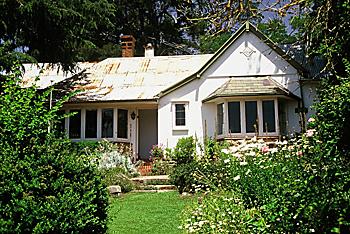
"The Cedars" - Heysen's home in Hahndorf
You can visit the house and Heysen's studio alongside it.
![]() The missionary Heinrich Friedrich Niemeyer arrived in Queensland on 28th June
with his family. He was sent by the Apostolic Church in Germany to establish
congregations in Australia. At first he and his family experienced incredible
hardships establishing a farm in the bush, but gradually he built up congregations
at Hatton Vale, Esk, Tarampa, Baffle Creek, Bundaberg, Mackay, Beenleigh and
other places. A church book published in 1908 about the development of the Church
in Queensland describes a few miracles that occurred as a result of the prayers
of Apostle Niemeyer (such as how he survived a poisonous snake bite on his thumb
early on: his hand and whole arm had already swelled up black and blue). In
1906 he made a trip to Germany, Switzerland and Holland, on which he made speeches
encouraging members of the Apostolic Church to emigrate to Australia to join
the congregations there. This caused around 600 German immigrants to go to Queensland
in the following three years.
The missionary Heinrich Friedrich Niemeyer arrived in Queensland on 28th June
with his family. He was sent by the Apostolic Church in Germany to establish
congregations in Australia. At first he and his family experienced incredible
hardships establishing a farm in the bush, but gradually he built up congregations
at Hatton Vale, Esk, Tarampa, Baffle Creek, Bundaberg, Mackay, Beenleigh and
other places. A church book published in 1908 about the development of the Church
in Queensland describes a few miracles that occurred as a result of the prayers
of Apostle Niemeyer (such as how he survived a poisonous snake bite on his thumb
early on: his hand and whole arm had already swelled up black and blue). In
1906 he made a trip to Germany, Switzerland and Holland, on which he made speeches
encouraging members of the Apostolic Church to emigrate to Australia to join
the congregations there. This caused around 600 German immigrants to go to Queensland
in the following three years.
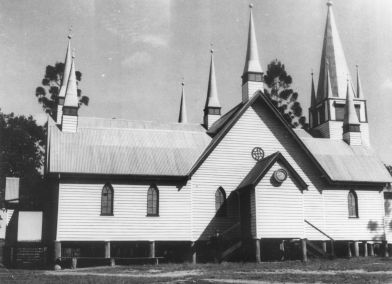
(Above) German Apostolic Church in Hatton Vale in 1935 (John Oxley Library, neg #53587)
1886
With the help of German government subsidies the German shipping line Norddeutscher Lloyd established a regular shipping service between Germany and Australia. This was advantageous to emigrants as there were now many departures for Australia each year, on average one a month. It also meant that emigrants' letters home to Germany and vice-versa reached their destination much faster.
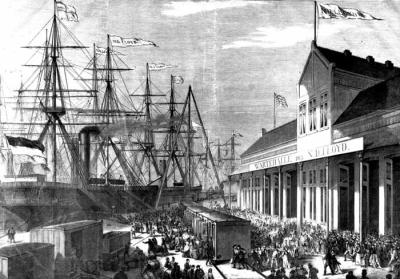
"The Norddeutsche Lloyd waiting room", at Bremerhaven New Harbour, 1870
Wood engraving, Historisches Museum Bremerhaven
1888
Robert Prenzel, one of Australia’s greatest wood carvers, arrived at Melbourne
on 24th November on the steamer Habsburg. Prenzel loved working
with a wide variety of Australian timbers and promoted their use for artistic
purposes.
More on Prenzel...
| [Diese Seite auf Deutsch] |
| Top | Back
| Chronology | Issues |
Students | Site Map
| auf Deutsch |
| Primary Sources (in German) | Bibliography
| Search |
German Australia © D. Nutting 2001